Key takeaways:
- Film editing relies on rhythm, pacing, continuity, and sound design to create an engaging viewer experience.
- Essential software tools like Adobe Premiere Pro, Final Cut Pro, and DaVinci Resolve can significantly enhance editing projects.
- Techniques such as visual symbolism, montage, and strategic pacing are critical for effective storytelling.
- Finalizing an edit involves meticulous attention to detail, embracing feedback, and trusting emotional instincts for a cohesive narrative.
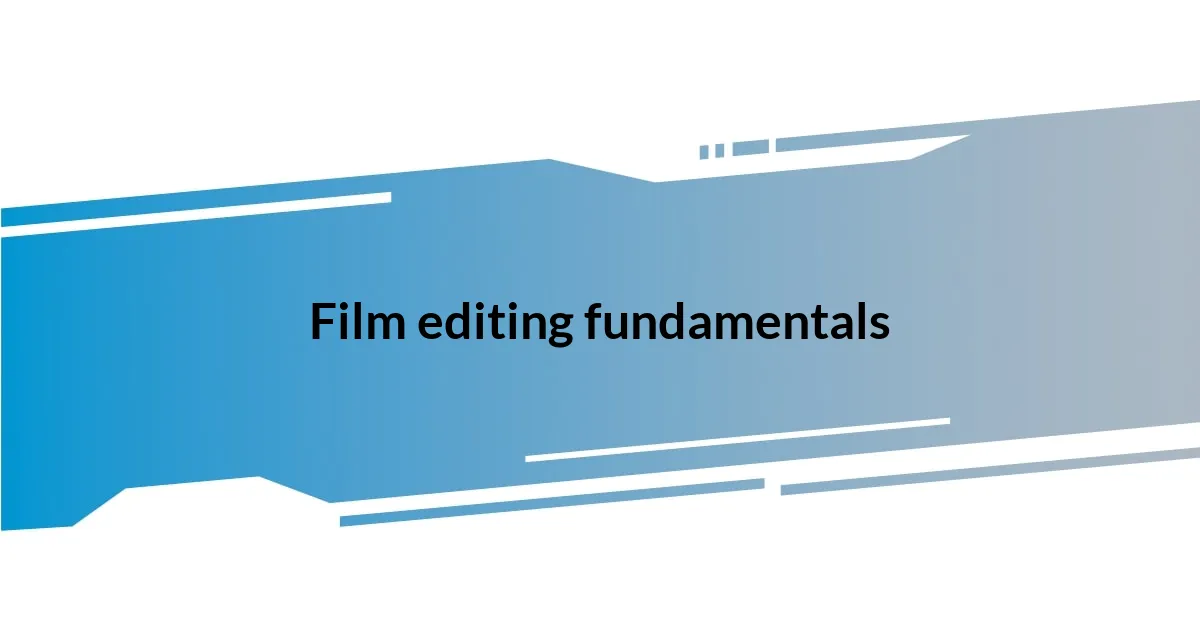
Film editing fundamentals
One of the fundamental aspects of film editing is the rhythm and pacing of a scene. I remember the first time I edited a project; I spent hours fine-tuning a single montage to create just the right energy. It felt like a dance, and I was learning to lead. How do you find that balance between the tension of the moment and the flow of the story?
Another essential element is the continuity of the narrative. When I was working on a short film, I had to piece together scenes shot on different days. It was challenging! I learned that maintaining visual and emotional continuity is crucial; it keeps the audience engaged and ensures they don’t feel jarred out of the experience. Have you ever watched a film and noticed how smoothly everything transitions? That’s no accident!
Lastly, sound editing can elevate a film to new heights. I distinctly recall adding sound effects to a critical action scene – it was transformative. The right sound can evoke fear, excitement, or nostalgia instantly. How can you harness sound to enhance your storytelling? It’s a powerful tool that I believe every editor should master.
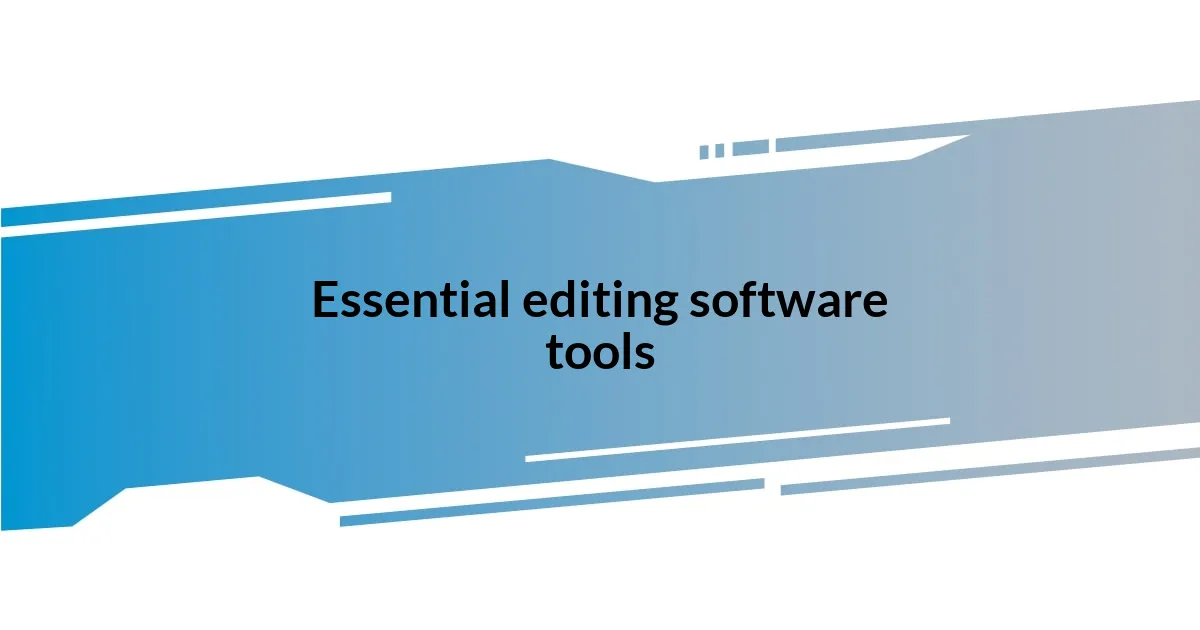
Essential editing software tools
When diving into the world of film editing, having the right software can make all the difference. Over the years, I’ve tried a variety of editing programs, and there are a few that truly stand out. I remember the first time I exported a project from Adobe Premiere Pro; the sense of accomplishment was unmatched. The sheer range of tools and effects made it easier to realize my creative vision.
Here are some essential editing software tools that can help elevate your projects:
- Adobe Premiere Pro: A go-to for many professionals, offering robust editing features.
- Final Cut Pro: Known for its intuitive interface, ideal for Mac users seeking speed and efficiency.
- DaVinci Resolve: Exceptional for color grading and is free for basic features—great for beginners.
- Avid Media Composer: The industry standard for big-budget productions, perfect for those looking to break into high-end editing.
- HitFilm Express: A free option that packs a punch, including VFX capabilities for those adventurous with visual effects.
Each one has unique strengths, and experimenting with them has been part of my learning journey. I recall using DaVinci Resolve for the first time; the process of color grading my footage felt like painting—a blend of art and technique that truly enhanced the storytelling.
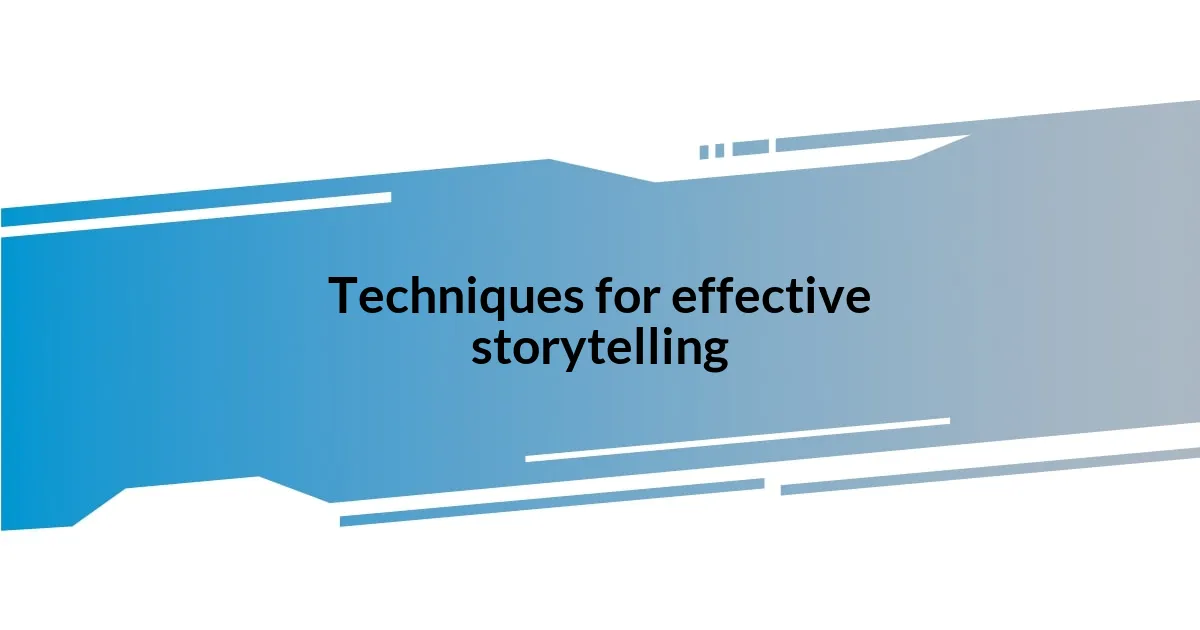
Techniques for effective storytelling
The power of visual symbolism in film editing can’t be overstated. I often think about how certain images or colors can evoke particular emotions. For instance, during a project that explored themes of hope and despair, I strategically used light colors in poignant moments and darker tones during the film’s more intense scenes. When you think about it, how do colors influence your perception of a story? It’s fascinating to see how a simple shift in hue can alter the audience’s emotional journey.
Another technique that has significantly shaped my storytelling is the use of montage. I can recall a time I edited a sequence of quick cuts that highlighted contrasting experiences of joy and sorrow. The juxtaposition of those moments created a deeper understanding of the characters’ journeys. Have you ever felt that a rapid sequence really captured the essence of a character? It’s a powerful way to convey emotion and intention while keeping the audience engaged.
Finally, pacing can either build suspense or deliver punchlines. I remember cutting a scene that relied heavily on timing; I had to experiment with the cuts—too fast, and the impact was lost; too slow, and the tension evaporated. This delicate balance is crucial, wouldn’t you agree? Getting it just right can transform a basic scene into something that lingers with the viewer long after the credits roll.
| Technique | Description |
|---|---|
| Visual Symbolism | Using colors and imagery to convey deeper meanings and emotions. |
| Montage | Quick cuts used to show contrasting experiences or highlight character development. |
| Pacing | The timing of cuts to either build tension or deliver impactful moments. |
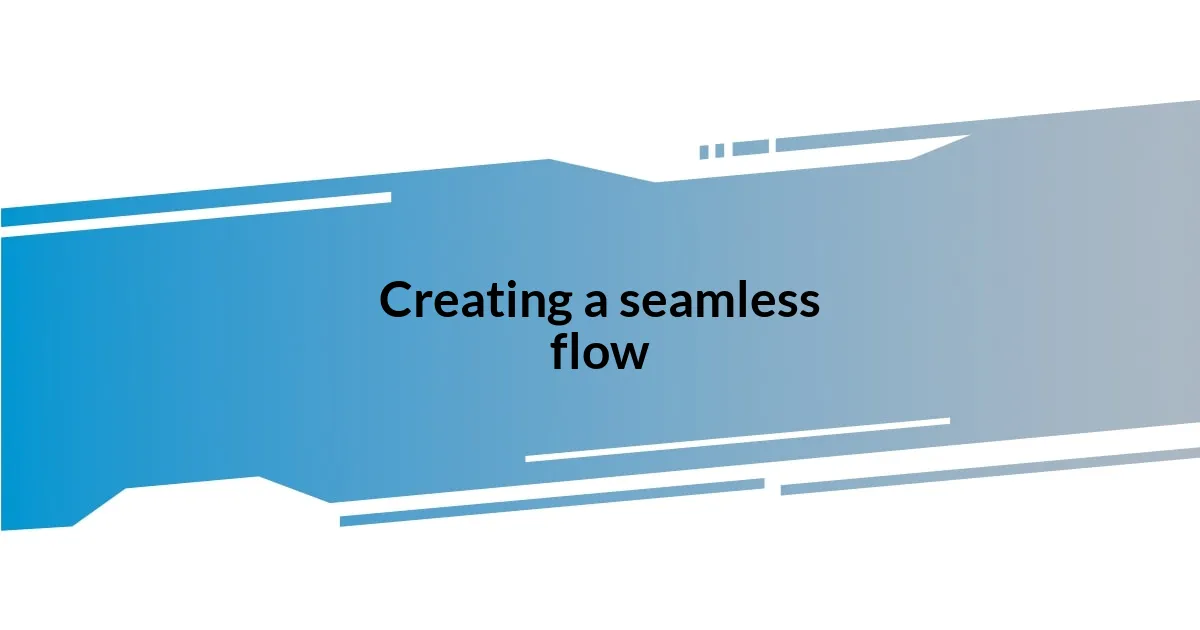
Creating a seamless flow
Creating a seamless flow in film editing is about rhythm and intuition. I find that the transition from one scene to another can either elevate or disrupt the storytelling experience. For instance, I once worked on a short film with a particularly emotional climax, where a swift jump cut from the protagonist’s despair to a flashback brought the audience closer to her journey. I remember the feedback from viewers—it was as if they were swept away in a wave of emotions. Have you noticed how a well-timed cut can create a visceral connection with the audience?
To me, pacing is like the heartbeat of the film. When editing a compelling narrative, I often play around with the length of my cuts to find that perfect tempo. There was a moment I edited a sequence that involved a tense confrontation. I intentionally extended the cuts during pauses, allowing the weight of silence to build anxious anticipation. It made the subsequent dialogue land with such impact that I could feel it even days later. Isn’t it curious how manipulation of time and timing can shape our viewing experience so profoundly?
Transitions also play a vital role in achieving a seamless flow. I’ve experimented with various types of transitions, from simple fades to more complex techniques like L-cuts or J-cuts. I fondly recall a project where L-cuts allowed audio from the next scene to leak into the previous one, creating a more immersive experience. It felt like I was drawing viewers into the world without them even realizing it. Have you tried these techniques? They can be surprisingly effective in maintaining the narrative’s momentum and keeping the audience engaged.
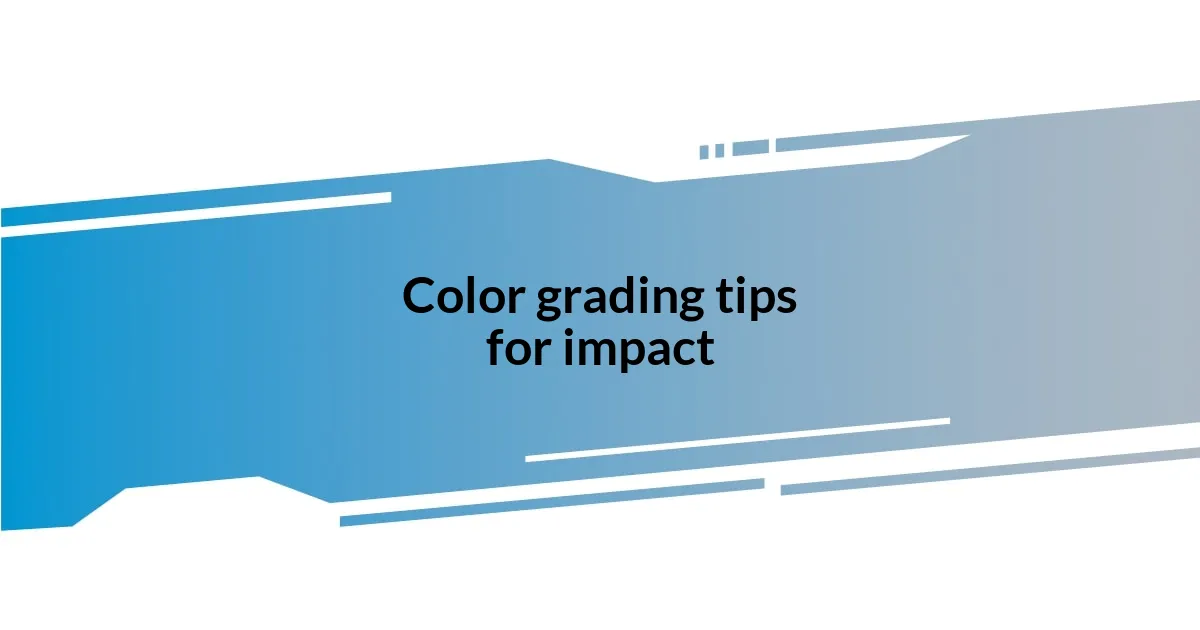
Color grading tips for impact
Color grading is one of those magical aspects of film editing that can truly elevate your story. I remember working on a documentary where the subject matter was both urgent and intimate. By applying a warm color palette during heartfelt moments, I could draw the audience in, while cooler hues during tense scenes created a palpable sense of distance. Have you ever noticed how color alone can change your emotional response to a scene? It’s amazing to see how subtle shifts can have a profound impact.
Choosing the right tones can be a delicate dance. In one project, I experimented with desaturation to convey isolation and nostalgia. I recall feeling that the muted colors effectively mirrored the character’s internal struggles. As I worked on that sequence, it struck me how even a simple adjustment in saturation could overhaul the entire atmosphere of the film. Have you ever tried desaturated tones? It can transform an ordinary moment into something extraordinarily poignant.
Consistency in color grading is crucial for creating a cohesive visual narrative. When I worked on a series of short films, I created a specific color scheme that ran throughout all episodes. This cohesive approach not only bridged the stories but also established a recognizable brand for the series. It was rewarding to see how audiences began to associate those colors with emotions—and with the characters themselves. So, when you’re color grading, ask yourself: what emotions do I want to evoke, and how can color help tell that story effectively?
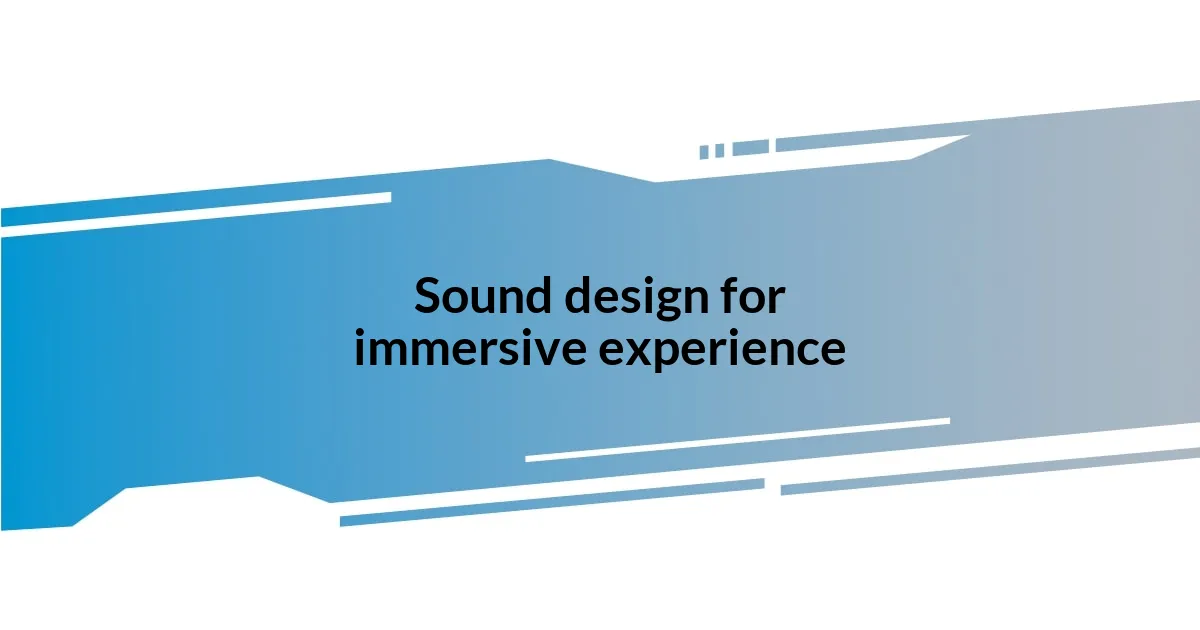
Sound design for immersive experience
Sound design is an often-underestimated aspect of creating an immersive film experience. When I was editing a horror short, I remember layering sounds so finely that the audience could almost feel the tension in the air. Every whisper of wind or distant creak added to the atmosphere, drawing viewers into the unsettling world. Isn’t it fascinating how sound can evoke emotions just as powerfully as visual elements?
I once collaborated on an indie film where I decided to incorporate ambient soundscapes to enhance the setting. By utilizing sounds from the environment—like rustling leaves or faint city hums—each scene felt more alive. I observed that audiences were not just watching; they were experiencing the world we crafted. Have you ever noticed how background sounds can transport you into the heart of a story, making every moment feel like a lived experience?
Then there’s the power of silence. In another project, I used silence strategically during moments of high emotional stakes, like a protagonist grappling with loss. I found that stripping away sound or music made the viewer lean in, captivated by the rawness of the character’s moment. After screening, I saw people emotionally unsteady, touched by the silence that spoke louder than any dialogue might. Have you tried employing silence as a tool? It can create a profound connection that lingers long after the credits roll.
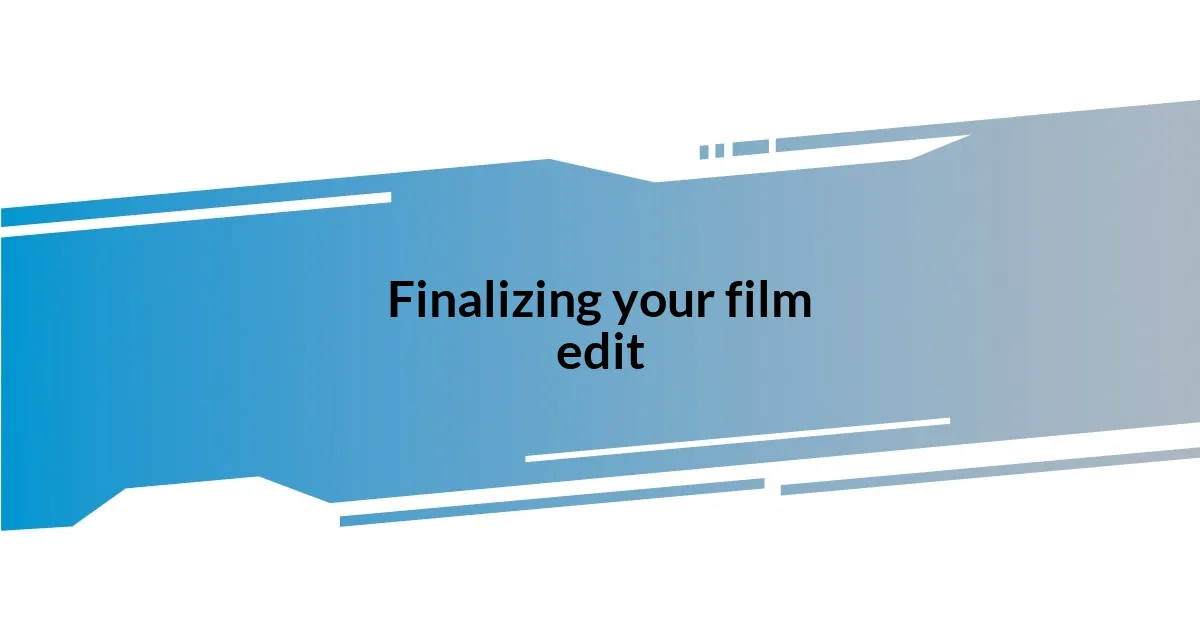
Finalizing your film edit
Finalizing your film edit can feel like both an exhilarating and daunting task. I vividly remember the moment I thought I was done with my last project, only to discover I missed a critical shot that changed the entire narrative’s flow. It’s such a pivotal moment; how do you decide what stays and what goes? Embracing feedback from trusted peers can be incredibly helpful—they often see things we overlook. Have you ever considered how a fresh perspective might transform your edit?
As I pieced together my final sequences, I made sure to meticulously comb through each cut, ensuring it flowed seamlessly into the next. I remember spending hours fine-tuning transitions and pacing, like when I discovered that a slight speed change could amplify the emotional impact of a scene. This is where attention to detail shines. Is there a moment that could benefit from a subtle adjustment? It’s those small changes that build a richer tapestry for your story.
The last stage is a mix of technical checks and emotional gut feeling. I once faced a situation where the color grading felt off, despite looking technically correct. I realized it was not just about how it looked on screen—it had to resonate emotionally. So, I took a break, returned with fresh eyes, and adjusted the color scheme to deepen the connection. Have you ever walked away only to return with a new sense of clarity? Trusting those instincts is vital in finalizing your film edit, as it can elevate your project beyond your original vision.
